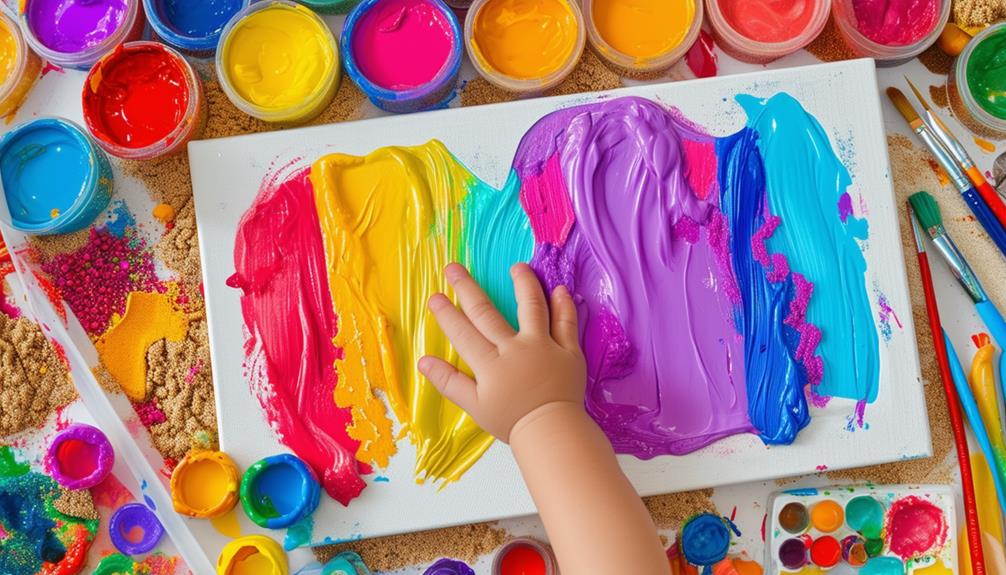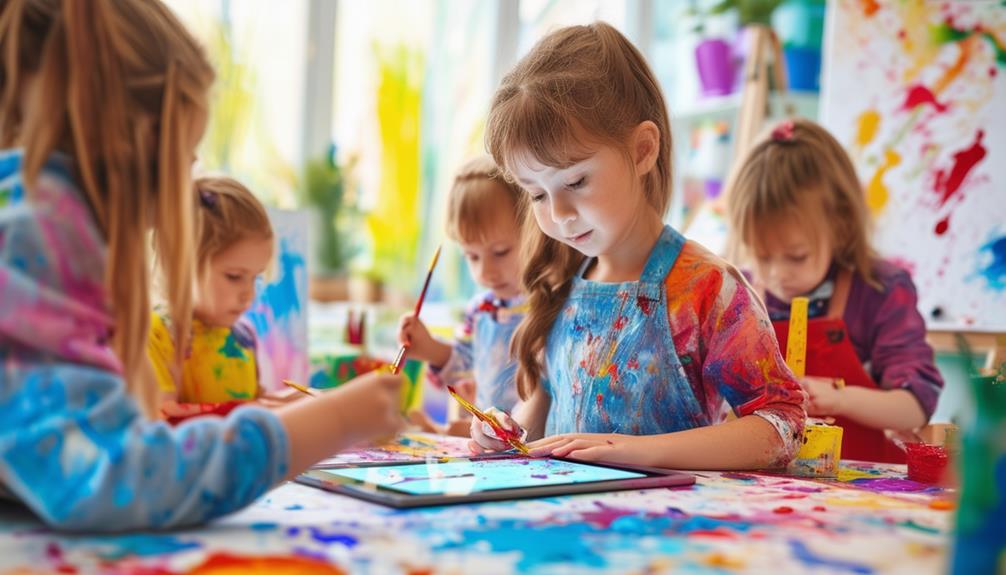How to Incorporate Painting Into Daily Learning Activities
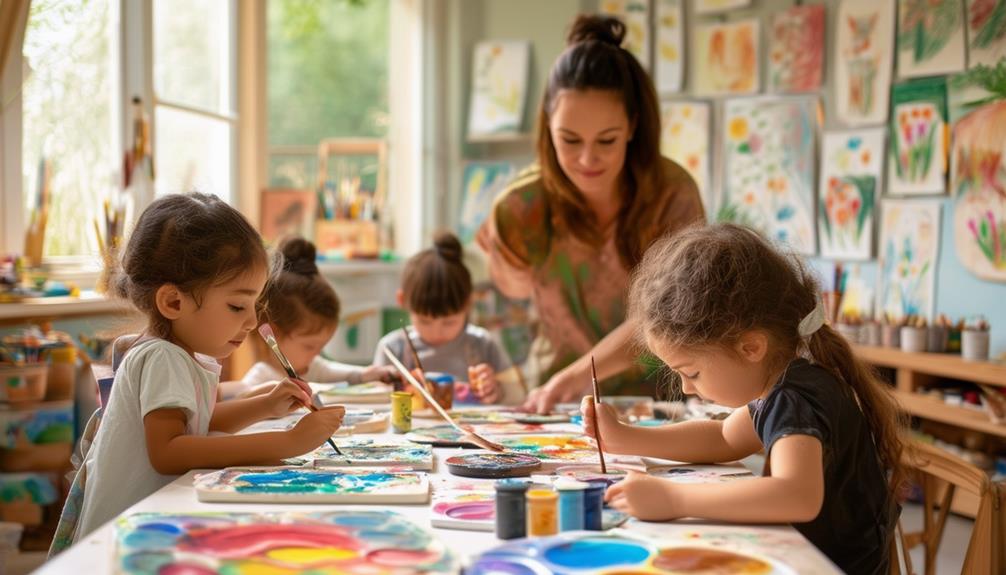
Incorporating painting into daily learning activities can significantly enhance the educational experience, making it more engaging and creative. Start by teaching basic painting techniques to develop fine motor skills and artistic confidence. Ensure you have the necessary materials and an efficient setup to minimize mess and maximize productivity. Connect painting with subjects like storytelling, science, or math to reinforce concepts interactively. Unique methods, such as combining painting with music and movement, can stimulate multiple senses. To make these activities a fundamental part of your daily routine, integrate them into your lesson plans consistently, ensuring they align with your educational goals.
Teaching Painting Techniques
To start teaching painting techniques, begin with the basics of color theory. Explain primary, secondary, and tertiary colors, and how they interact. This foundational knowledge is essential for students to create a wide range of hues and shades in their work.
Once students understand color theory, demonstrate various painting techniques such as stippling, dry brushing, and layering. Show how stippling creates texture with small dots, dry brushing leaves light, feathery strokes, and layering adds depth and richness. These techniques will help students explore different effects and develop their own artistic style.
Encourage experimentation with different brush types like flat, round, and filbert brushes. Each brush produces unique textures and strokes, helping students understand how tool selection impacts their artwork. Additionally, guide them on effective color mixing and blending to create smooth gradients and new shades.
For younger artists, introduce the crayon resist technique. Have them draw with crayons and then paint over with watercolors. The crayon resists the paint, revealing unique patterns and designs. This simple yet engaging method will spark their creativity and exploration.
Essential Materials and Setup
When preparing for a painting session, having the right materials and an organized space is essential for a successful and enjoyable experience. Start by gathering your necessary supplies: acrylic paint, watercolor, and oil paints. Acrylic paint is particularly versatile and beginner-friendly, making it ideal for daily learning activities.
Offer a variety of paintbrushes in different sizes to encourage experimentation and aid in developing fine motor skills. Smaller brushes are excellent for detail work, while larger ones are suitable for broader strokes and background fills.
Next, arrange your space with palettes, water cups, and canvases within easy reach to ensure a smooth workflow and reduce interruptions. Good lighting is crucial; it assists with accurate color perception and reduces eye strain. Position your workspace near a natural light source or use bright, white artificial lighting.
Don't forget protective layers like table covers and aprons to minimize mess and safeguard clothing. This simple step can simplify cleanup and alleviate stress. By focusing on these elements, you'll create a conducive environment for creativity and learning through painting activities.
Efficient Paint Distribution

Enhance your painting sessions with practical methods for efficient paint distribution. Start by using labeled egg cartons to organize and distribute paint for each table. This approach not only saves time but also helps students develop essential organizational skills.
Store acrylic paints in sealed plastic bins within the egg cartons for easy access and to prevent drying out. When distributing specific colors, use plastic trays and 2 oz. plastic cups to provide each table with the exact amount of paint needed.
For even more efficiency, use ketchup bottles for controlled paint dispensing, which reduces waste and ensures consistency. Alternatively, consider watercolors or tempera cakes for a mess-free and convenient option.
Here's a quick reference table for these efficient distribution methods:
| Method | Use Case |
|---|---|
| Egg Cartons | Organize and distribute by table |
| Sealed Plastic Bins | Store acrylic paint |
| Plastic Trays & Cups | Distribute specific colors |
| Ketchup Bottles | Controlled paint dispensing |
| Watercolors/Tempera | Mess-free and convenient option |
These methods ensure an organized, efficient, and effective painting experience.
Minimizing Mess
To minimize mess while painting, start by organizing your materials with appropriate storage solutions. Efficient cleaning techniques, such as using a 'hot tub' for palettes and keeping washcloths handy, will facilitate quick and easy cleanup. This method not only maintains a tidy workspace but also prolongs the lifespan of your tools.
Organized Material Storage
Organizing your painting materials using plastic trays and 2 oz. plastic cups can significantly minimize mess and confusion. This method is essential for visual arts and ensures that art lessons proceed smoothly. By assigning specific trays and cups for each color, you can prevent accidental spills and mix-ups.
Using ketchup bottles and buckets to distribute paints further controls spillage and keeps your workspace tidy. The precision of ketchup bottles allows you to dispense just the right amount of paint, reducing waste and mess. Additionally, buckets for larger quantities make it easier to refill trays and cups without causing chaos.
To maintain order, soak your palettes in warm water for easy cleaning. This minimizes mess and ensures your materials are ready for the next session. Providing washcloths for cleaning spills and wiping tables is another simple yet effective strategy. This helps keep the environment clean and organized, allowing you to focus on creativity rather than cleanup.
Lastly, cleaning brushes in warm water is cost-effective and promotes sustainability. By reusing materials, you reduce waste and save on expenses, enabling you to invest more in quality supplies for your art classroom.
Efficient Cleaning Techniques
Efficient cleaning techniques are essential when painting to maintain a tidy workspace and minimize mess. Begin by using washcloths to quickly clean spills and wipe surfaces. This helps keep the art room organized, allowing students to focus on developing their artistic skills without distractions.
Instead of using plastic palettes, which can be difficult to clean, consider soaking your palettes in warm soapy water for easier cleaning. This method not only reduces mess but also prolongs the life of your palettes. Protect your tables with newspaper, which can also serve as a drying area for brushes. This simple, disposable solution helps keep your space organized.
Aprons or old clothes are crucial for protecting clothing from paint splatters. Encourage students to wear them to minimize cleanup after painting activities. By using aprons, students develop a habit of staying clean while being creative.
Encouraging Creativity
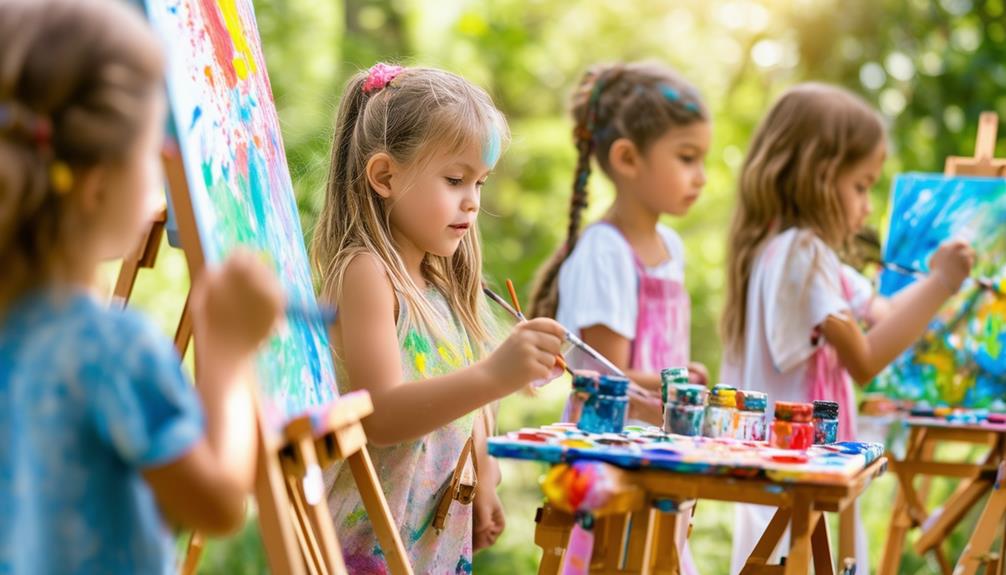
Encouraging creativity through painting allows students to explore their imagination and convey unique ideas. By promoting experimentation with various painting techniques, you enable them to discover a multitude of possibilities. Provide open-ended prompts that stimulate creative thinking; for instance, ask them to depict an emotion or a concept rather than a specific object. This approach allows them to interpret the prompt in their own distinctive way.
Fostering creativity also involves encouraging the use of diverse painting methods and styles. Allow students to mix colors, use different brushes, or incorporate unconventional materials like sponges or leaves. The aim is to establish an environment where they can try new things without fear of criticism.
Celebrate their individual artistic choices by showcasing their work and offering positive feedback. When students feel their unique expressions are valued, they are more likely to take creative risks. Create a supportive and non-judgmental atmosphere that nurtures artistic growth. Encourage them to share their thoughts and ideas about their own work and that of others, fostering a community of mutual respect and inspiration.
Art in Other Subjects
Incorporating art into other subjects can make learning more engaging and effective. For example, students can observe changes in plants through painting, or explore geometric shapes and measurements in math through drawing. Using art to depict historical events or critique famous works can deepen understanding in social studies and enhance writing skills.
Integrating Art With Science
Many scientific concepts become clearer to students when they observe and document changes in living things through painting. By integrating art with science, you can help students visualize and better understand the processes they study. For instance, when students paint the growth stages of a plant, they grasp the lifecycle in a more vivid and detailed manner. This method also allows them to notice minute changes they might otherwise overlook.
In social studies, art serves as a powerful tool for depicting historical events. When students paint scenes from history, they engage more deeply with the material, fostering a richer understanding of the events and cultures they study. This multidisciplinary approach helps students make connections between different subjects, reinforcing their learning in both areas.
To blend art with science and social studies, consider incorporating these activities:
- Document Plant Growth: Have students paint the different stages of a plant's life cycle.
- Historical Event Scenes: Encourage students to paint key moments from historical events they are studying.
- Science Experiment Results: Let students paint the results of science experiments, capturing changes and outcomes visually.
Math Concepts Through Painting
Painting not only brings history and science to life but also makes math concepts like geometry, fractions, and symmetry more tangible and engaging for students. By incorporating painting into your lessons, you can transform abstract math principles into hands-on activities.
For instance, students apply geometry by creating shapes and measuring their dimensions in artworks. Mixing and blending colors offers a practical way to explore fractions and proportions. Symmetry and patterns become clearer when students replicate mirrored images or design repetitive motifs.
Here's how you can integrate these math concepts with painting:
| Math Concept | Painting Activity |
|---|---|
| Geometry | Drawing and measuring shapes |
| Fractions | Mixing paint in specific ratios |
| Symmetry | Creating symmetrical artworks |
| Patterns | Designing repetitive motifs |
These activities not only reinforce mathematical skills but also make the learning process enjoyable. When students paint, they can visualize mathematical principles, making them more approachable. Encouraging creativity through art also helps in developing problem-solving skills and enhancing cognitive abilities.
Expressing Ideas Through Drawing
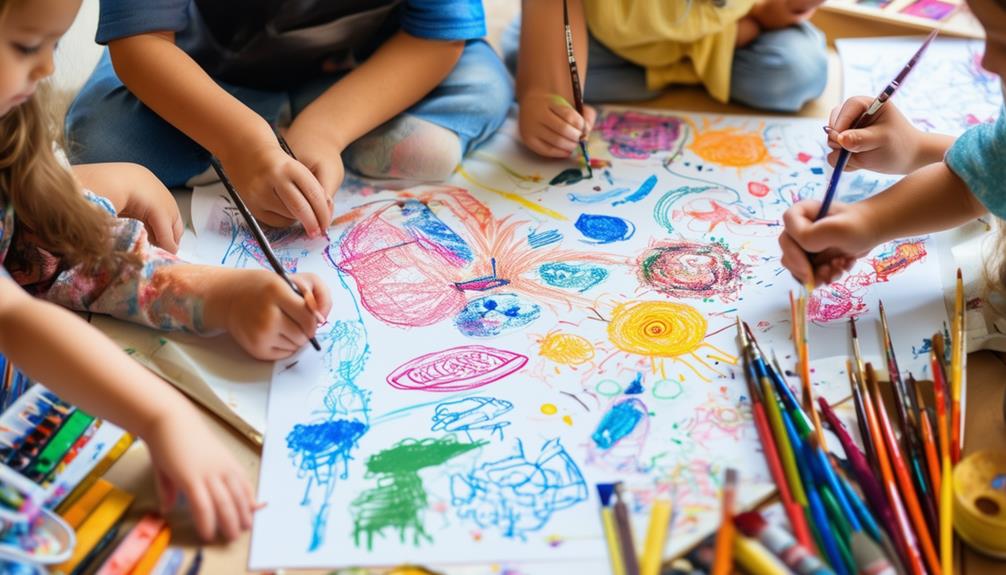
Harnessing creativity, drawing serves as a powerful medium for students to articulate their thoughts, ideas, and emotions. It offers a unique way for students to investigate complex concepts, making learning more engaging and relatable. Not only does drawing help in expressing ideas, but it also enriches vocabulary, grammar, and writing skills. When students use tools like oil pastels, they can experiment with textures and colors, making their drawings vibrant and expressive.
Incorporating drawing into daily learning activities is simple and effective. For instance, in literature, students can illustrate scenes from a story, and in science, they can draw diagrams to better understand processes. Visuals in art notably improve comprehension, connecting written words to tangible images.
- Communication: Drawing allows students to visually communicate their ideas, making abstract concepts more concrete.
- Engagement: Art activities like using oil pastels keep students engaged and motivated to learn.
- Comprehension: Drawing helps students grasp and retain information better by linking it to specific topics or texts.
Understanding Through Artifacts
Creating artifacts such as dioramas and models can significantly enhance the comprehension of complex concepts across various subjects. Integrating art into educational activities helps students grasp intricate details and historical events more effectively. Artistic representations make abstract ideas more tangible, aiding in both visualization and internalization of information.
Constructing these artifacts not only boosts learning but also aids retention. This hands-on approach encourages deeper exploration into study units, leading to a more thorough understanding. It is particularly beneficial for subjects like history, science, and geography.
Here's how different artifacts can facilitate learning:
| Subject | Artifact | Learning Outcome |
|---|---|---|
| History | Historical Dioramas | Improved grasp of historical events |
| Science | Scientific Models | Better visualization of complex scientific concepts |
| Geography | Topographical Models | Enhanced understanding of geographical features |
| Literature | Scene Re-creations | In-depth analysis of literary scenes |
This approach ensures a more interactive and engaging learning experience, making it easier for students to retain and apply knowledge.
Learning Through Role-Play
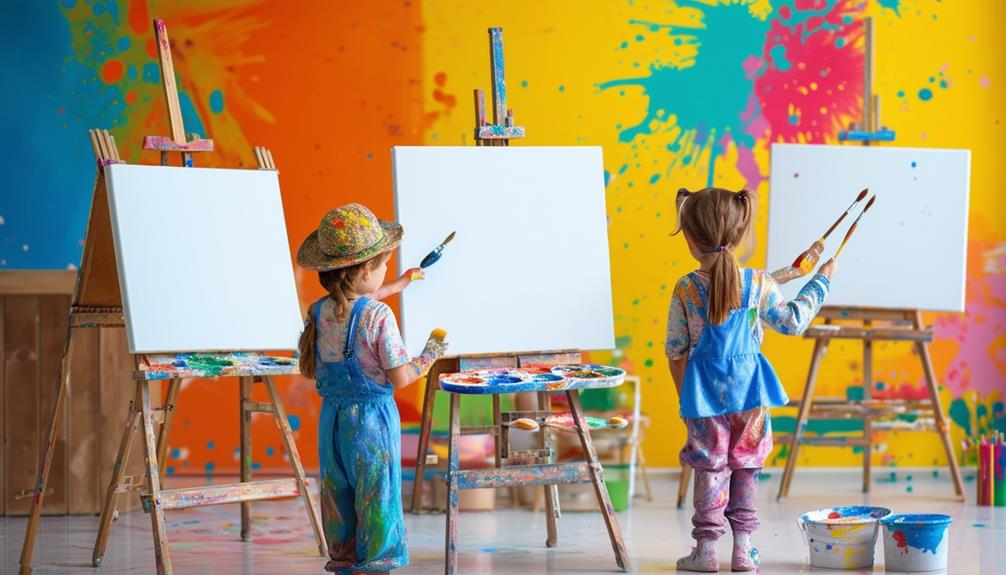
Role-playing enables students to deeply engage with stories, characters, and events, making learning both captivating and memorable. By acting out parts of a text, students enhance their comprehension and retention of information. This hands-on learning approach boosts confidence and helps students grasp complex topics more effectively.
Incorporating role-playing into lessons transforms students from passive listeners into active participants. This method encourages them to embody different characters, thereby improving their empathy and perspective-taking skills. Additionally, the interactive nature of role-play makes learning more enjoyable and less intimidating.
To make your role-playing sessions even more effective, consider these tips:
- Use props and settings: Enhance the immersive experience with simple props and background settings related to the story or event.
- Encourage creativity: Allow students to improvise and add their own twists to the roles they are portraying.
- Facilitate teamwork: Have students collaborate in groups to plan and perform their role-plays, fostering teamwork and communication skills.
Enhancing Learning With Movement
Incorporating movement into painting activities can transform the educational experience for high school students, adding a dynamic and interactive element to their learning process.
Imagine students acting out historical events or characters while painting. This method not only makes lessons more engaging but also helps them better understand and retain historical content. By connecting emotionally and physically with the art, students gain a deeper appreciation for the subject matter.
Integrating dance movements into painting activities further enriches this experience. When students use dance to express their interpretations, they engage multiple senses, making the learning process more immersive. Additionally, moving to music from different historical periods during painting sessions turns learning into a fun, culturally enriching activity.
Movement stimulates creativity, enhances retention, and makes learning more meaningful. By integrating physical activity into art, high school students can tap into their creative potential while solidifying their understanding of diverse subjects. Encourage your students to move, dance, and paint their way to a more vibrant and memorable educational experience.

